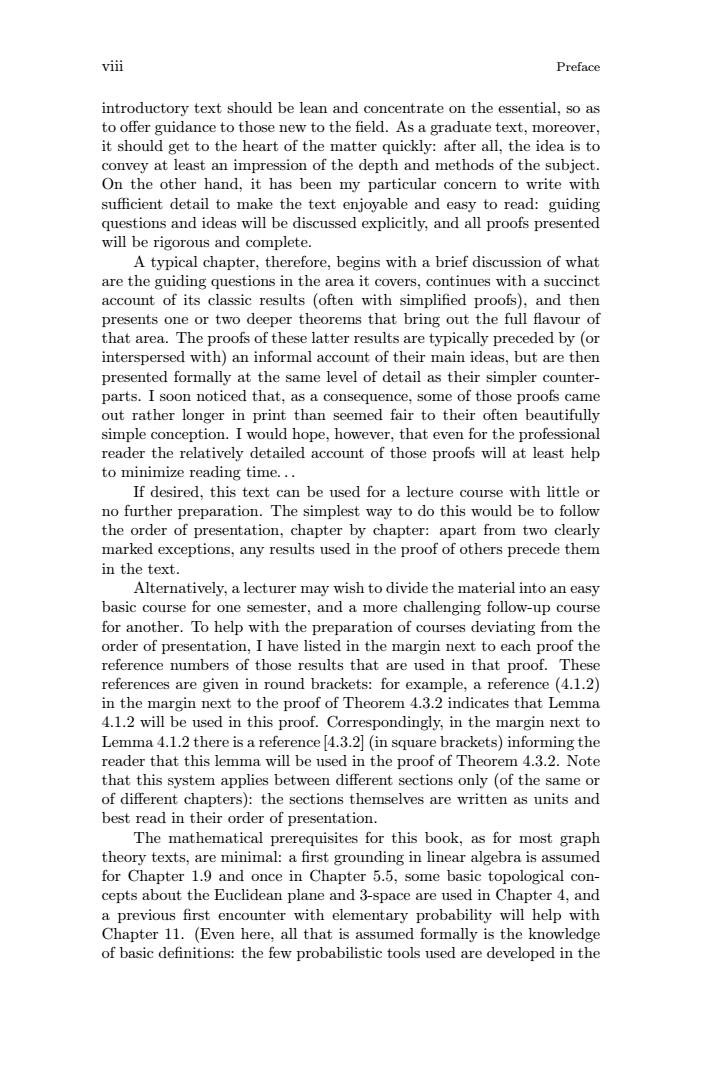正在加载图片...

viiPrefaceintroductory text should be lean and concentrate on the essential, so asto offer guidance to those new to the field. As a graduate text, moreoverit should get to the heart of the matter quickly:after all, the idea is toconvey at least an impression of the depth and methods of the subject.On the other hand, it has been my particular concern to write withsufficient detail tomake the text enjoyable and easy to read: guidingquestions and ideas will be discussed explicitly, and all proofs presentedwill be rigorous and complete.A typical chapter, therefore, begins with a brief discussion of whatare the guiding questions in the area it covers, continues with a succinctaccount of its classic results (often with simplified proofs),and thenpresents one or two deeper theorems that bring out the full flavour ofthat area. The proofs of these latter results are typically preceded by (orinterspesed with) an informal account of their main ideas, but are thenpresented formally at the same level of detail as their simpler counterparts. I soon noticed that, as a consequence, some of those proofs camout rather longer in print than seemed fair to their often beautifullysimple conception. I would hope, however, that even for the professionalreader the relatively detailed account of those proofs will at least helpto minimize reading time.If desired, this text can be used for a lecture course with little orno further preparation. The simplest way to do this would be to followthe order of presentation, chapter by chapter:apart from two clearlymarked exceptions, any results used in the proof of others precede themin the text.Alternatively,a lecturermaywishtodividethematerial into an easybasic course for oneester,and a more challengingfollow-up coursefor anotherTohelpwiththepreparation of courses deviatingfrom theorderofprentation,I have listed in themargin next to each proof thereferennumbersofthoseresults that are used in that proof. TheserefereI round brackets: for example, a reference (4.1.2)saregiven inext to the proof of Theorem 4.3.2 indicates that Lemmanthe:4.1.2 will be used in this proof. Correspondingly, in the margin next toLemma 4.1.2 there is a reference [4.3.2] (in square brackets) informing thereader that this lemma will be used in the proof of Theorem 4.3.2. Notethat this system applies between different sections only (of the same orof different chapters):the sections themselves are written as units andbest read in their order of presentation.The mathematical prerequisites for this book, as for most graphimal: a first grounding in linear algebra is assexts.for Chapter 1.9 and once in Chapter 5.5, some basic topological concepts about the Euclidean plane and 3-space are used in Chapter 4, anda previous first encounter with elementary probability will help withChapter 1l. (Even here, all that is assumed formally is the knowledgeofbasic definitions:thefewprobabilistictoolsused aredeveloped intheviii Preface introductory text should be lean and concentrate on the essential, so as to offer guidance to those new to the field. As a graduate text, moreover, it should get to the heart of the matter quickly: after all, the idea is to convey at least an impression of the depth and methods of the subject. On the other hand, it has been my particular concern to write with sufficient detail to make the text enjoyable and easy to read: guiding questions and ideas will be discussed explicitly, and all proofs presented will be rigorous and complete. A typical chapter, therefore, begins with a brief discussion of what are the guiding questions in the area it covers, continues with a succinct account of its classic results (often with simplified proofs), and then presents one or two deeper theorems that bring out the full flavour of that area. The proofs of these latter results are typically preceded by (or interspersed with) an informal account of their main ideas, but are then presented formally at the same level of detail as their simpler counterparts. I soon noticed that, as a consequence, some of those proofs came out rather longer in print than seemed fair to their often beautifully simple conception. I would hope, however, that even for the professional reader the relatively detailed account of those proofs will at least help to minimize reading time... If desired, this text can be used for a lecture course with little or no further preparation. The simplest way to do this would be to follow the order of presentation, chapter by chapter: apart from two clearly marked exceptions, any results used in the proof of others precede them in the text. Alternatively, a lecturer may wish to divide the material into an easy basic course for one semester, and a more challenging follow-up course for another. To help with the preparation of courses deviating from the order of presentation, I have listed in the margin next to each proof the reference numbers of those results that are used in that proof. These references are given in round brackets: for example, a reference (4.1.2) in the margin next to the proof of Theorem 4.3.2 indicates that Lemma 4.1.2 will be used in this proof. Correspondingly, in the margin next to Lemma 4.1.2 there is a reference [4.3.2] (in square brackets) informing the reader that this lemma will be used in the proof of Theorem 4.3.2. Note that this system applies between different sections only (of the same or of different chapters): the sections themselves are written as units and best read in their order of presentation. The mathematical prerequisites for this book, as for most graph theory texts, are minimal: a first grounding in linear algebra is assumed for Chapter 1.9 and once in Chapter 5.5, some basic topological concepts about the Euclidean plane and 3-space are used in Chapter 4, and a previous first encounter with elementary probability will help with Chapter 11. (Even here, all that is assumed formally is the knowledge of basic definitions: the few probabilistic tools used are developed in the